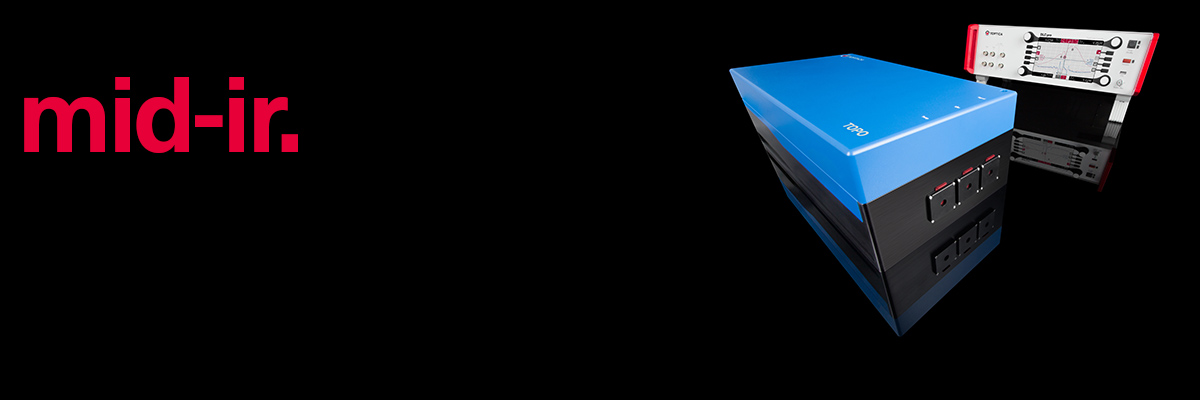- 1.43 - 4.2 µm (2400 - 7000 cm-1)
- 300 GHz (10 cm-1) mode-hop-free tuning range
- Narrow linewidth: 2 MHz (1·10-4 cm-1)
- Hands-free motorized tuning
- Easy all-digital DLC pro control
MIR spectroscopy has never been easier. The powerful TOPO delivers wide tunability, narrow linewidth, and convenient hands-free digital control. There are no modules to exchange and no adjustments to be made by hand. Ease of use and reliable performance make this CW OPO the right choice for challenging applications in MIR spectroscopy and quantum optics.
The revolutionary TOPO by TOPTICA stands alone as the only fully automated, continuous-wave, singly-resonant optical parametric oscillator laser source on the market. High resolution spectroscopy across
1.43 – 4.2 µm (2400 – 7000 cm-1) has never been easier.
TOPTICA’s unique optical design enables broadly tunable laser light. No module or mirror exchange is necessary. Additionally, the all-digital control electronics enable hands-free coarse tuning, and frequency locking. A wide mode-hop-free tuning range up to 300 GHz (10 cm-1) enables visibility of full spectroscopic signatures. Simultaneously, the TOPO maintains a narrow linewidth (2 MHz, 1·10-4 cm-1) giving a solution that reveals narrow atomic and molecular features.
TOPTICA's OPO laser system won the Prism Awards 2019 for scientific lasers at Photonics West!
Contact an Expert
Specifications
| DLC TOPO | Signal | Idler | |
|---|---|---|---|
| Coarse tuning range* Standard system | 1.45 - 2.07 µm | 2.19 - 4.00 µm | 2500 - 4570 cm-1 (idler), 4830 - 6900 cm-1 (signal) |
| Coarse tuning range* High-power system | 1.43 - 2.06 µm | 2.20 - 4.3 µm | 2400 -4570 cm-1 (idler), 4830 - 6990 cm-1 (signal) |
| Output Power** Standard / High Power | 2 W / 4 W | 1 W / 2 W | |
| Linewidth | < 100 kHz | 2 MHz | <1x10-4 cm-1 |
| Mode hop free tuning range*** | < 1 GHz | Up to 300 GHz**** | Up to 10 cm-1 (idler) |
| Beam Quality Factor M2** | < 1.2 | < 1.2 | |
| Frequency modulation and lock | PZT modulation | PZT modulation, Pump frequency modulation | |
| Control interfaces | DLC pro touchscreen, PC software, Ethernet, USB, analog remote control | ||
* Course tuning is established by full automatic crystal shifting and temperature control. No optics exchange necessary
** Specifications valid 1.53 - 2 µm, 2.2 - 3.6 µm
*** Fine tuning is established via pump tuning (idler) and PZT tuning (signal and idler)
**** 30 GHz - 300 GHz, depending on output wavelength
Options
Narrow Linewidth
The optical spectrum of the idler output is a convolution of the seed laser and signal spectra. The standard TOPO uses the DLC DFB pro as its seed, with 2 MHz linewidth. An alternate seed option is the DLC CTL 1050, which has < 10 kHz linewidth. This results in an idler linewidth of < 100 kHz.
Fiber Coupling (FiberDock)
TOPTICA’s patented fiber coupler provides highest single-mode fiber-coupling efficiencies, easy alignment and at the same time highest stability. With this option, fiber coupling is added TOPO signal and idler probe outputs for convenient power and wavelength monitoring. TOPTICA additionally offers a wide range of single-mode and polarization-maintaining fibers, including fiber-optic beam splitters.
Laser Locking Electronics
A broad variety of electronic locking modules is available for frequency stabilization.
- Literature
- Whitepaper:Enabling high-resolution spectroscopy over the molecular stretch region, 2020
- Poster: David Foote Broadly-tunable, High-resolution Mid-IR Spectroscopy, CLEO 2020
- Article: Ulrich Eismann Direct and frequency-converted diode lasers provide all wavelengths for holography, Laser Focus World (2018), German version, Chinese version, Japanese version, French version
- Article: R. Kirner et al., Mask-aligner lithography using a continuous-wave diode laser frequency-quadrupled to 193 nm, Optics Express (2018)
- Article: Active and passive stabilization of a high-power UV frequency-doubled diode laser, CLEO, OSA Technical Digest (Optical Society of America, 2016)
- Article: Short, shorter, shortest: Diode lasers in the deep ultraviolet, Laser Focus World, June 2016
- Article: Kurz, kürzer, am kürzesten, Best of (2015)
- Article: More colors! Diode lasers reach Yellow and Orange, Physics' Best (2013)
- Article: Frequenzkonvertierte cw-Lasersysteme für Forschung und Industrie, Physik Journal (2007)


